Passive Time-Division Multiplexing Fiber Optic Sensor for Magnetic Field Detection Applications in Current Introduction
Abstract
1. Introduction
2. Principles and Structures
- sj represents the loss factor of the optical signal in the transmission path before entering the coupler OC5.
- dk represents the loss factor of the path from the output of OC5 to the reception by the photodetector.
- ρjk denotes the phase characteristics of the signal.
3. Experimental Results and Discussions
4. Conclusions
Author Contributions
Funding
Institutional Review Board Statement
Informed Consent Statement
Data Availability Statement
Conflicts of Interest
References
- Wu, J.; Zhang, X. Recent Progress of All Fiber Optic Current Transformers. In Proceedings of the 2020 7th International Forum on Electrical Engineering and Automation (IFEEA), Hefei, China, 25–27 September 2020. [Google Scholar]
- Sima, W.; Zeng, L.; Yang, M.; Yuan, T.; Sun, P. Improving the temperature and vibration robustness of fiber optic current transformer using fiber polarization rotator. IEEE Trans. Instrum. Meas. 2022, 71, 1–12. [Google Scholar] [CrossRef]
- Li, Z.; Cui, J.; Chen, H.; Lu, H.; Zhou, F.; Rocha, P.R.F.; Yang, C. Research Progress of All-Fiber Optic Current Transformers in Novel Power Systems: A Review. Microw. Opt. Technol. Lett. 2025, 67, e70061. [Google Scholar] [CrossRef]
- Gao, H.; Wang, G.; Gao, W.; Li, S. A chiral photonic crystal fiber sensing coil for decreasing the polarization error in a fiber optic current sensor. Opt. Commun. 2020, 469, 125755. [Google Scholar] [CrossRef]
- Gubin, V.P.; Przhiyalkovskiy, Y.V.; Starostin, N.I.; Morshnev, S.; Sazonov, A. A broadband Faraday fiber-optic current sensor with excess noise compensation. Results Phys. 2020, 18, 103286. [Google Scholar] [CrossRef]
- Leal-Junior, A.; Díaz, C.; Frizera, A.; Lee, H.; Nakamura, K.; Mizuno, Y.; Marques, C. Highly Sensitive, Fiber-Optic Intrinsic Electromagnetic Field Sensing. Adv. Photonics Res. 2020, 2, 2000078. [Google Scholar] [CrossRef]
- Yan, D.; Chen, H.; Cheng, Q.; Wang, H. Enhanced Faraday effect by magneto-plasmonic structure design composed of bismuth-iron garnet. Opt. Laser Technol. 2023, 161, 109193. [Google Scholar] [CrossRef]
- Sun, T.; Yang, K.; Hao, D.; Hu, J.; Wang, X.; Dong, W.; Ding, K.; Kong, L. Temperature self-compensating photonic crystal fiber grating magnetic field sensor. Opt. Eng. 2024, 63, 036105. [Google Scholar] [CrossRef]
- Wang, G.; Wu, Y.; Guan, X.; Chen, X.; Yu, X. Highly sensitive fiber vector magnetic field sensor based on an open-cavity Mach-Zehnder interferometer filled with magnetic fluid. Sens. Actuators A Phys. 2025, 381, 116075. [Google Scholar] [CrossRef]
- Ning, Y.; Guo, H.; Qin, Y.; Zhang, Y.; Li, S.; Mou, J.; Zhang, M.; Zhang, Y.; Liu, Z.; Zhang, J.; et al. Ultrasensitive Fiber SPR Magnetic Field Sensor Using Au/TiO2 Schottky Junction. IEEE Sens. J. 2023, 23, 13823–13828. [Google Scholar] [CrossRef]
- Wu, J.; Zhang, X.; Chen, L.; Wu, B.; Peng, C. Research on All-Fiber Dual-Modulation Optic Current Sensor Based on Real-Time Temperature Compensation. IEEE Photonics J. 2022, 14, 1–9. [Google Scholar] [CrossRef]
- Li, Y.; Han, Y. Modeling and analysis of vibration characteristics of all fiber current sensor. In Proceedings of the 2021 International Conference on Neural Networks, Information and Communication Engineering, SPIE, Qingdao, China, 27–28 August 2021; Volume 11933, pp. 506–518. [Google Scholar]
- Huang, Y.; Xia, R. Polarization evolution in spun quarter wave plate and its influence on FOCS performance. J. Light. Technol. 2024, 42, 3891–3900. [Google Scholar] [CrossRef]
- Xin, G.; Zhu, J.; Luo, C.; Tang, J.; Li, W.; Cao, Y.; Xu, H. Polarization Error Analysis of an All-Optical Fibre Small Current Sensor for Partial Discharge. J. Electr. Eng. Technol. 2020, 15, 2199–2210. [Google Scholar] [CrossRef]
- Yang, H.; Qiao, L.; Yang, Y.; Huang, W.; Sun, S. Thermally induced error analysis and suppression of optic fiber delay loop in the different variable rate of temperature. Optik 2019, 193, 162994. [Google Scholar] [CrossRef]
- Chen, S.; Liu, Z.; Niu, X.; Huang, J.; Zhao, L.; Ke, Y.; Xia, L. Highly Sensitive Fiber Optic Current Sensors with Integrated λ/4 Retarder. Microw. Opt. Technol. Lett. 2024, 66, e70025. [Google Scholar] [CrossRef]
- Tian, J.; Yu, A.; Wang, Z.; Xia, L. A differential-self-multiplication demodulation algorithm for fiber optic current sensor. Opt. Laser Technol. 2024, 169, 110041. [Google Scholar] [CrossRef]
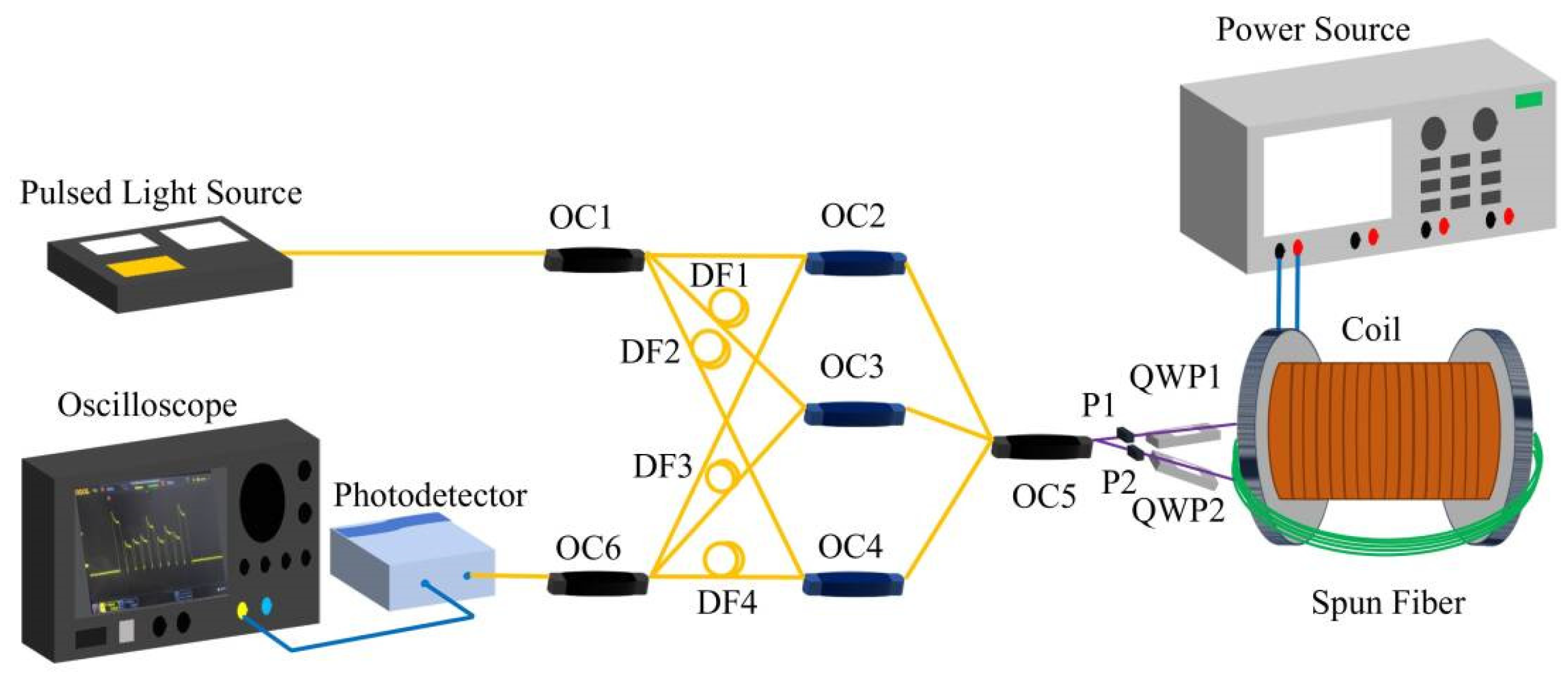
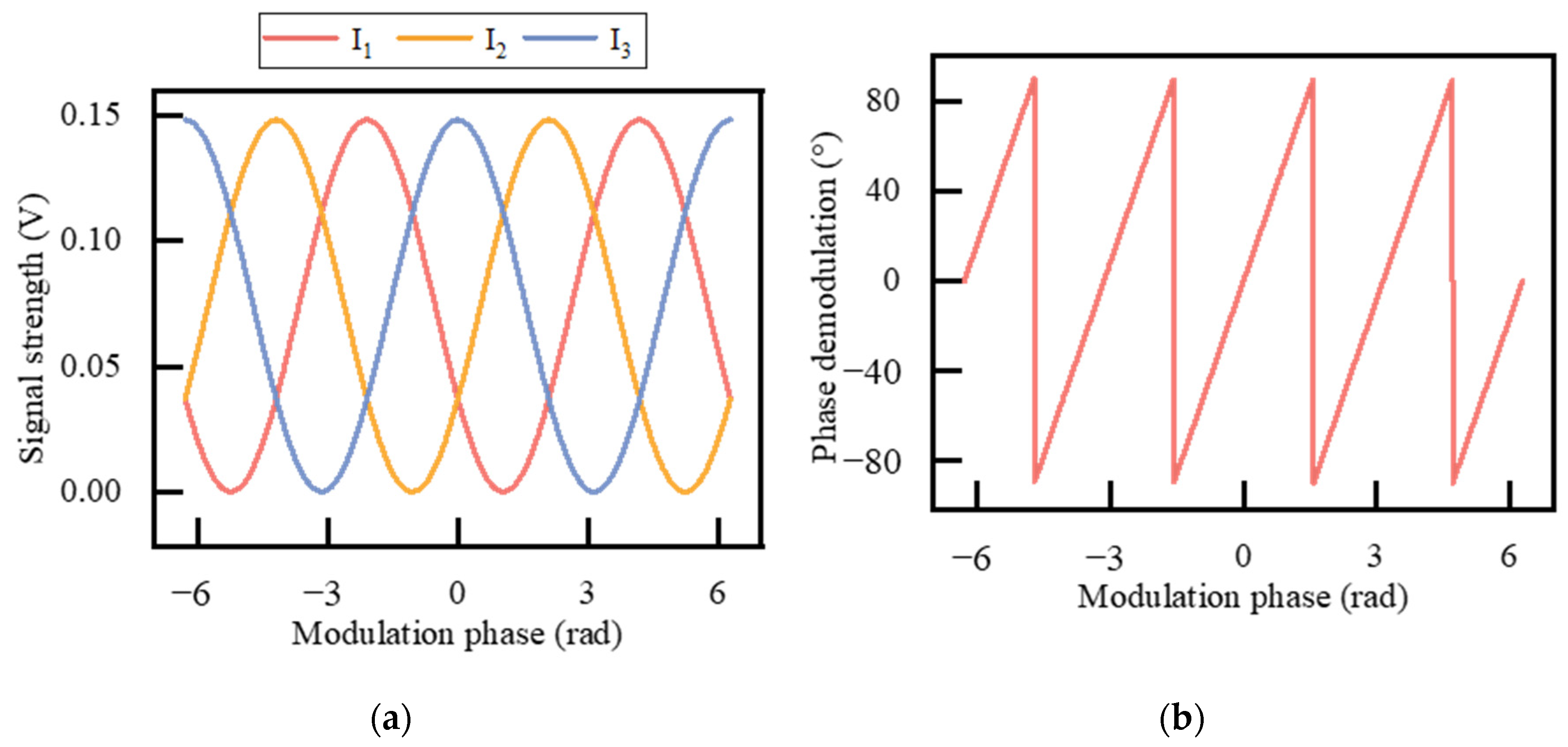

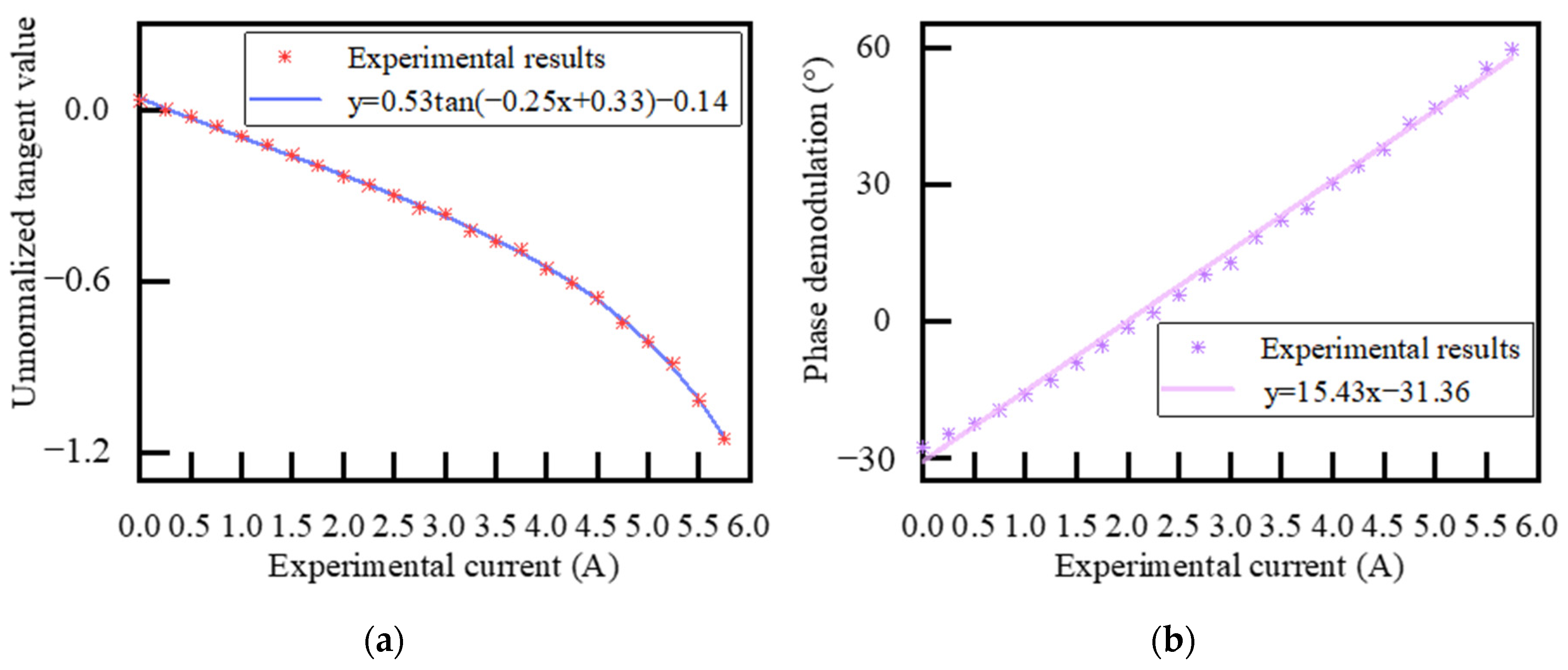
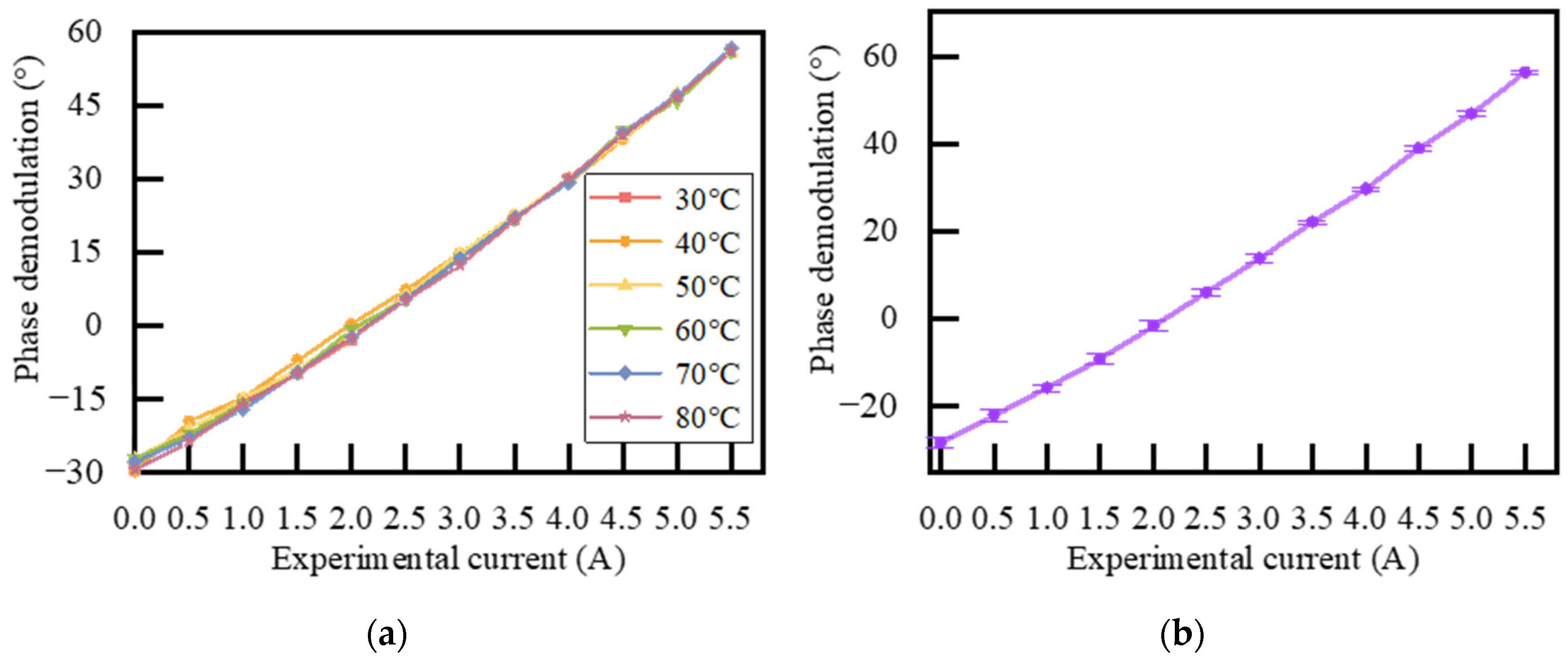
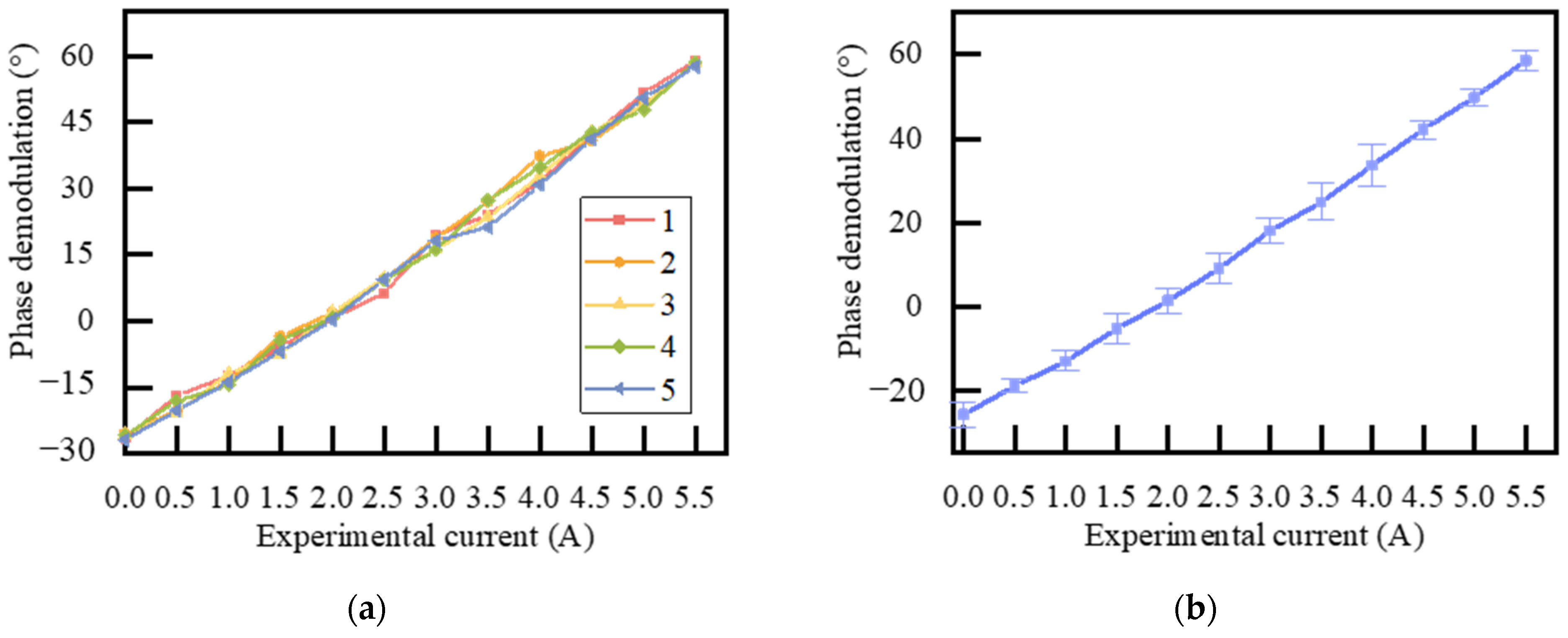
Disclaimer/Publisher’s Note: The statements, opinions and data contained in all publications are solely those of the individual author(s) and contributor(s) and not of MDPI and/or the editor(s). MDPI and/or the editor(s) disclaim responsibility for any injury to people or property resulting from any ideas, methods, instructions or products referred to in the content. |
© 2025 by the authors. Licensee MDPI, Basel, Switzerland. This article is an open access article distributed under the terms and conditions of the Creative Commons Attribution (CC BY) license (https://creativecommons.org/licenses/by/4.0/).
Share and Cite
Liu, Y.; Xiong, J.; Huang, J.; Pang, F.; Zhao, Y.; Xia, L. Passive Time-Division Multiplexing Fiber Optic Sensor for Magnetic Field Detection Applications in Current Introduction. Photonics 2025, 12, 506. https://doi.org/10.3390/photonics12050506
Liu Y, Xiong J, Huang J, Pang F, Zhao Y, Xia L. Passive Time-Division Multiplexing Fiber Optic Sensor for Magnetic Field Detection Applications in Current Introduction. Photonics. 2025; 12(5):506. https://doi.org/10.3390/photonics12050506
Chicago/Turabian StyleLiu, Yong, Junjun Xiong, Junchang Huang, Fubin Pang, Yi Zhao, and Li Xia. 2025. "Passive Time-Division Multiplexing Fiber Optic Sensor for Magnetic Field Detection Applications in Current Introduction" Photonics 12, no. 5: 506. https://doi.org/10.3390/photonics12050506
APA StyleLiu, Y., Xiong, J., Huang, J., Pang, F., Zhao, Y., & Xia, L. (2025). Passive Time-Division Multiplexing Fiber Optic Sensor for Magnetic Field Detection Applications in Current Introduction. Photonics, 12(5), 506. https://doi.org/10.3390/photonics12050506





